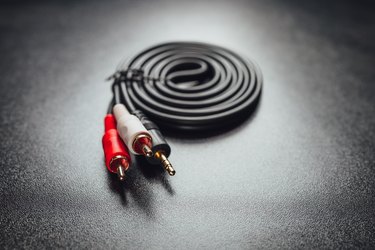
Keeping a box of spare cables lying around might be infuriating to neat freaks, but it can save you a lot of frustration when you're trying to connect audio and video equipment. Ideally, you'd always have the right cable for the job, but sometimes you can improvise. If you have an extra component cable on hand, for example, you can use it as a substitute for the older style RCA audio video cables.
Covering the Basics
Video of the Day
The red, green and blue wires that make up a component cable look just like the red, white and yellow cord you'd use to attach to the old-school audio-video RCA inputs on the back of an old television or another piece of vintage equipment. That's because they use the same basic technology. They're still made up of a central wire that carries the signal, guarded by a shielding made of foil or a braided outer wire, and they end in color-coded RCA connectors. The main difference between them is that component cables are made to carry a higher bandwidth, high-definition signal, so they use higher quality connector wires and shielding.
Video of the Day
Connecting With a Component Cable
The bottom line is that if you don't have an old-school red, yellow and white cable lying around, you can use a red, green and blue component cable to do the same job. The only issue you face is making sure you connect the cables the same way at each end since you won't have the handy color code to keep things simple. Start by connecting the red cable to the red RCA connector on each piece of equipment because they already match. Then, decide whether the blue or green is the video connector. It might help to wrap one of them with tape and mark each end of your chosen cable with yellow to remind yourself which is the video connection. As long as each cable goes to the matching RCA connection at each end, you should get your audio and video signals just fine.
The Reverse Isn't Always True
You might assume that if you can connect regular RCA audio video gear with a component cable, you can also use a red, yellow and white cord to connect up a newer piece of equipment with component video connections. You'd be right, up to a point, because you will get a picture. Unfortunately, the older cable is only designed to carry audio on its red and white wires, which means it's got a lot less bandwidth than you need for a modern high-definition video signal. It'll work in a pinch, but you'll lose video quality.
More Complicated Scenarios
Either of those situations is relatively straightforward because you're connecting two pieces of equipment that are designed to use the same kind of signal. It's not as simple if you are attaching a modern device with component video to an older one that has RCA audio video inputs. Those are completely different types of signals, so you need to buy a separate RCA-to-component video adapter box to convert them. In total, you need five connections on the component side – three for video, plus the left and right audio – along with the traditional red, white and yellow outputs on the other side for the older piece of equipment to plug into. These can be costly, though, so it's often simpler to upgrade your equipment.